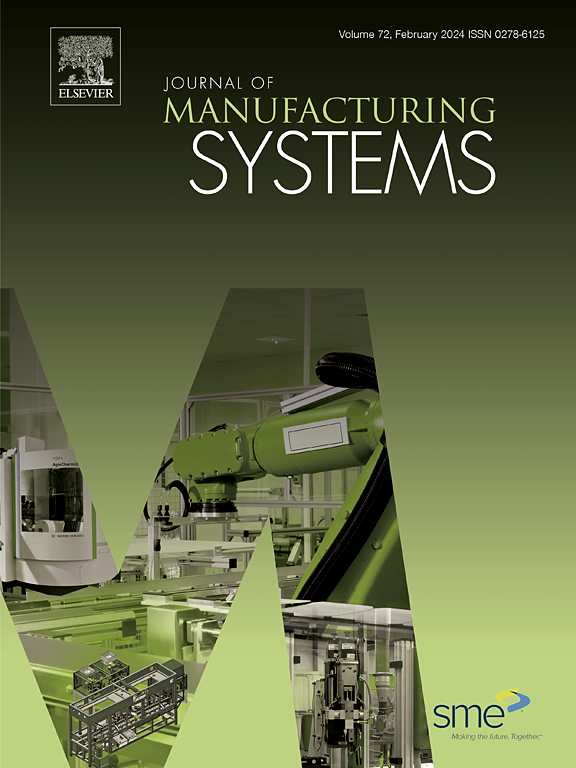基于多任务深度强化学习的批量铣削系统加工参数优化
IF 12.2
1区 工程技术
Q1 ENGINEERING, INDUSTRIAL
引用次数: 0
摘要
在批量铣削系统中,加工参数的多目标综合优化是提高加工质量和效率的重要方法。由于批量铣削系统状态的变化,连续使用相同的加工参数可能导致批量加工工件的质量和效率下降。加工参数优化通常是通过人工经验或试错法确定的,难以实现质量和效率的协同考虑。针对这一问题,提出了一种新的多任务深度强化学习方法,用于批量加工系统的加工参数优化。首先,采用多任务时间序列估计方法,建立了可靠的多个加工质量和效率指标的并行联合估计模型,该模型可以学习这些指标之间的相关性,提高了估计精度;然后,将参数优化问题形式化为一个由强化学习虚拟环境和智能体支持的马尔可夫决策过程。为了提高优化后加工参数的精度,构建了带有联合估计模型的强化学习虚拟环境,用于质量和效率指标的协同优化。在虚拟环境中,定义了时间序列序列状态、序列动作、多目标奖励函数和适应联合估计模型的约束条件,对不同的加工参数进行重复评估。为了提高优化过程的稳定性,设计了具有多头关注和动态权重调节机制的agent。最后,在薄壁零件实际加工数据集上的实验表明,与传统的深度强化学习算法相比,所提框架的优化效果提高了9% ~ 12%,标准差降低了9% ~ 18%。本文章由计算机程序翻译,如有差异,请以英文原文为准。
Machining parameter optimization for a batch milling system using multi-task deep reinforcement learning
The integrated multi-objective optimization of machining parameters for improved machining quality and efficiency is important in batch milling systems. Due to the change of the batch milling system state, the continuous use of the same machining parameters may lead to degradation in quality and efficiency for workpieces in batches. Machining parameter optimization is usually determined by manual experience or trial-and-error methods, making it difficult to achieve a synergistic consideration of both quality and efficiency. To address this issue, a novel multi-task deep reinforcement learning method for machining parameter optimization in a batch machining system is proposed. Firstly, a reliable parallel joint estimation model of multiple machining quality and efficiency indicators is established using a multi-task time series estimation method, which can learn the correlation of these indicators to improve estimation accuracy. Then, the parameter optimization problem is formalized as a Markov decision process supported by a reinforcement learning virtual environment and an agent. The reinforcement learning virtual environment with the joint estimation model is constructed to improve the accuracy of optimized machining parameters for the collaborative optimization of quality and efficiency indicators. Within the virtual environment, time series sequential state, sequential action, multi-objective reward function, and constraint conditions adapted to the joint estimation model are defined to repeatedly evaluate different machining parameters. The agent with a multi-head attention and a dynamic weight adjustment mechanism is designed to improve the stability of the optimization process. Finally, experiments on a real machining dataset of thin-walled parts show that compared with the traditional deep reinforcement learning algorithm, the optimization effect of the proposed framework is improved by 9 %−12 %, and the standard deviation is decreased by 9 % −18 %.
求助全文
通过发布文献求助,成功后即可免费获取论文全文。
去求助
来源期刊

Journal of Manufacturing Systems
工程技术-工程:工业
CiteScore
23.30
自引率
13.20%
发文量
216
审稿时长
25 days
期刊介绍:
The Journal of Manufacturing Systems is dedicated to showcasing cutting-edge fundamental and applied research in manufacturing at the systems level. Encompassing products, equipment, people, information, control, and support functions, manufacturing systems play a pivotal role in the economical and competitive development, production, delivery, and total lifecycle of products, meeting market and societal needs.
With a commitment to publishing archival scholarly literature, the journal strives to advance the state of the art in manufacturing systems and foster innovation in crafting efficient, robust, and sustainable manufacturing systems. The focus extends from equipment-level considerations to the broader scope of the extended enterprise. The Journal welcomes research addressing challenges across various scales, including nano, micro, and macro-scale manufacturing, and spanning diverse sectors such as aerospace, automotive, energy, and medical device manufacturing.
 求助内容:
求助内容: 应助结果提醒方式:
应助结果提醒方式:


